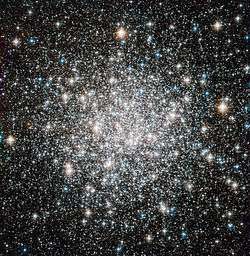Messier 68
| Messier 68 | |
|---|---|
|
| |
| Observation data (J2000 epoch) | |
| Class | X[1] |
| Constellation | Hydra |
| Right ascension | 12h 39m 27.98s[2] |
| Declination | –26° 44′ 38.6″[2] |
| Distance | 33.6 kly (10.3 kpc)[3] |
| Apparent magnitude (V) | +9.67[4] |
| Apparent dimensions (V) | 11′.0 |
| Physical characteristics | |
| Mass | 2.23×105[3] M☉ |
| Radius | 53 ly[5] |
| Metallicity | = –2.23[3] dex |
| Estimated age | 11.2 Gyr[6] |
| Notable features | Relatively metal poor.[3] |
| Other designations | M68, NGC 4590, GCl 20[4] |
Messier 68 (also known as M68 or NGC 4590) is a globular cluster in the equatorial constellation Hydra. It was discovered by Charles Messier in 1780. William Herschel described it as "a beautiful cluster of stars, extremely rich, and so compressed that most of the stars are blended together". His son John noted that it was "all clearly resolved into stars of 12th magnitude, very loose and ragged at the borders".[7]

M68 is at a distance of about 33,000 light-years away from Earth and is orbiting through the galaxy with a large eccentricity of 0.5. This orbit carries it as far as 100,000 light years from the galactic center.[7] It is one of the most metal-poor globular clusters, which means it has a paucity of elements other than hydrogen and helium. The cluster may be undergoing core-collapse, and it displays signs of being in rotation. The cluster may have been acquired by the Milky Way galaxy through accretion from a satellite galaxy.[8]
All told, as of 2015 a total of 50 variable stars have been identified in this cluster; the first 28 being identified as early as 1919−1920 by American astronomer Harlow Shapley. Most of the variables are of type RR Lyrae, or periodic variables. Six of the variables are of the SX Phoenicis variety, which display short pulsating behavior.[8]
References
- ↑ Shapley, Harlow; Sawyer, Helen B. (August 1927), "A Classification of Globular Clusters", Harvard College Observatory Bulletin (849): 11–14, Bibcode:1927BHarO.849...11S
- 1 2 Goldsbury, Ryan; et al. (December 2010), "The ACS Survey of Galactic Globular Clusters. X. New Determinations of Centers for 65 Clusters", The Astronomical Journal, 140 (6): 1830–1837, arXiv:1008.2755
 , Bibcode:2010AJ....140.1830G, doi:10.1088/0004-6256/140/6/1830.
, Bibcode:2010AJ....140.1830G, doi:10.1088/0004-6256/140/6/1830. - 1 2 3 4 Boyles, J.; et al. (November 2011), "Young Radio Pulsars in Galactic Globular Clusters", The Astrophysical Journal, 742 (1): 51, arXiv:1108.4402
 , Bibcode:2011ApJ...742...51B, doi:10.1088/0004-637X/742/1/51.
, Bibcode:2011ApJ...742...51B, doi:10.1088/0004-637X/742/1/51. - 1 2 "SIMBAD Astronomical Database". Results for NGC 4590. Retrieved 2006-11-17.
- ↑ distance × sin( diameter_angle / 2 ) = 53 ly. radius
- ↑ Sollima, A.; et al. (April 2008), "The correlation between blue straggler and binary fractions in the core of Galactic globular clusters", Astronomy and Astrophysics, 481 (3): 701–704, arXiv:0801.4511
 , Bibcode:2008A&A...481..701S, doi:10.1051/0004-6361:20079082
, Bibcode:2008A&A...481..701S, doi:10.1051/0004-6361:20079082 - 1 2 Stoyan, Ronald; Binnewies, Stefan; Friedrich, Susanne (2008), Atlas of the Messier Objects: Highlights of the Deep Sky, translated by Schroeder, Klaus-Peter, Publisher Cambridge University Press, p. 826, ISBN 1139473115.
- 1 2 Kains, N.; Arellano Ferro, A.; Figuera Jaimes, R.; Bramich, D. M.; Skottfelt, J.; Jørgensen, U. G.; Tsapras, Y.; Street, R. A.; Browne, P.; Dominik, M.; Horne, K.; Hundertmark, M.; Ipatov, S.; Snodgrass, C.; Steele, I. A.; Lcogt/Robonet Consortium; Alsubai, K. A.; Bozza, V.; Calchi Novati, S.; Ciceri, S.; D'Ago, G.; Galianni, P.; Gu, S.-H.; Harpsøe, K.; Hinse, T. C.; Juncher, D.; Korhonen, H.; Mancini, L.; Popovas, A.; Rabus, M.; Rahvar, S.; Southworth, J.; Surdej, J.; Vilela, C.; Wang, X.-B.; Wertz, O.; Mindstep Consortium (June 2015), "A census of variability in globular cluster M 68 (NGC 4590)", Astronomy & Astrophysics, 578: 23, arXiv:1502.07345
 , Bibcode:2015A&A...578A.128K, doi:10.1051/0004-6361/201424600, A128.
, Bibcode:2015A&A...578A.128K, doi:10.1051/0004-6361/201424600, A128.
External links
![]() Media related to Messier 68 at Wikimedia Commons
Media related to Messier 68 at Wikimedia Commons
- Globular Cluster M68 @ SEDS Messier pages
- Messier 68, Galactic Globular Clusters Database page
- Messier 68 on WikiSky: DSS2, SDSS, GALEX, IRAS, Hydrogen α, X-Ray, Astrophoto, Sky Map, Articles and images
Coordinates: ![]() 12h 39m 28.01s, −26° 44′ 34.9″
12h 39m 28.01s, −26° 44′ 34.9″

